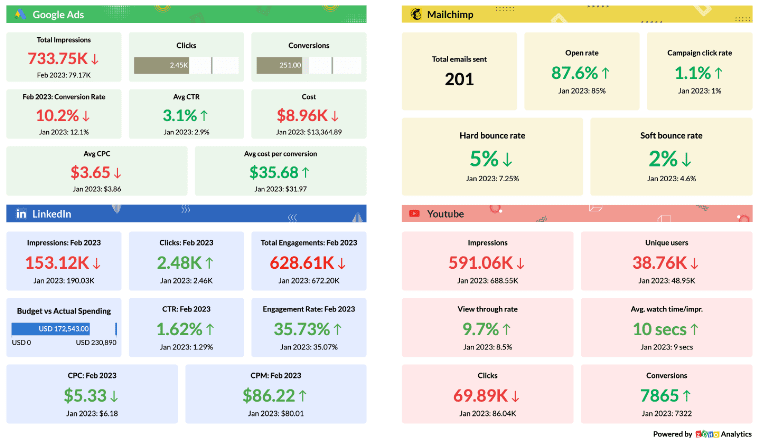As an entrepreneur, one of the key aspects of growing your business is building strong relationships with your customers. In the digital age we live in now, that means not only giving your customers great products and services but also talking to them through different channels. In this article, we'll look at some of the best ways for entrepreneurs to keep customers interested.
What is the meaning of customer engagement strategies?
What is the meaning of customer engagement strategies?
Customer engagement strategies are a set of things that businesses do to build strong relationships with their customers. These strategies help businesses learn more about their customers, give them a good experience, and make them more loyal. They involve activities such as personalized communication, targeted offers, surveys, loyalty programs, and more. Businesses can make sure they are giving their customers the best service possible and improve their bottom line by putting in place effective strategies for customer engagement.
What are the 4 types of engagement?
What are the 4 types of engagement?
Building a Strong Social Media Presence
Social media is one of the most powerful tools available for connecting with customers. Platforms like Facebook, Twitter, and Instagram allow you to share updates, promotions, and other content that can help keep your customers engaged and interested in your business. But it's not enough just to have a presence on these platforms - you need to actively engage with your customers by responding to comments, messages, and reviews, and by sharing valuable content that will keep them coming back.
Personalizing Your Marketing Efforts
In today's digital age, customers expect a personalized experience. One way to do this is by segmenting your audience and tailoring your marketing efforts to specific groups. For example, you might create different email campaigns for different segments of your customer base, or create special promotions for specific groups of customers. Personalizing your marketing efforts will make your customers feel valued, and will help build stronger relationships with them.
Creating a Community Around Your Brand
Another effective customer engagement strategy is to create a community around your brand. This can be done through various means, such as social media groups, forums, or even in-person events. By creating a community, you'll give your customers a place to connect with each other, share ideas, and discuss your products and services. This can help build brand loyalty and make customers more likely to return to your business.
Providing Exceptional Customer Service
Finally, one of the most important customer engagement strategies is to provide exceptional customer service. This means responding quickly to customer inquiries, addressing concerns, and going above and beyond to ensure that customers are satisfied. Providing excellent customer service will not only keep current customers happy, but it will also attract new customers who hear about your great service.
Customer engagement is a measurement of how enthusiastic your company's customers are. Your customer engagement strategy has the potential to make or break your company. The connection is straightforward: if you have a positive impact on your customers, you will gain more business because happy customers are brand ambassadors. Here's a blog post about customer engagement for Generation Y and Z.
Customer engagement is a process, not a one-time event. There is also no one-size-fits-all solution. What works for one company may not work for another. Your best bet is to know your audience, devise your own master plan that incorporates the tried-and-true customer engagement strategies listed below, and then constantly test its efficacy. In this blog, we'll go over the nine tried-and-true customer engagement strategies for entrepreneurs:
1. Get to know your customer's
1. Get to know your customer's

Creating a customer engagement strategy for startups without knowing who you're attempting to reach and what they truly require is akin to shooting in the dark. By identifying your target audience, you can tailor your engagement strategy to best meet their specific needs and preferences.
Analyzing customer behavior with website visitor tracking allows you to build customer profiles based on metrics that are important to you—location, job role, industry, website footprint, interaction history, and more—and then engage each persona in a way that drives results. For example, if you discover that a significant portion of your audience is made up of young professionals in the tech industry, you can create content and campaigns that specifically cater to their interests and needs. Additionally, by tracking website interactions, you can identify which pages and products are most popular among different customer segments, allowing you to optimize your website and product offerings to better serve your audience.
2. Improve your website's user experience
2. Improve your website's user experience

Your website is the face of your company and the focal point of your customer's interactions with your brand. It is crucial that it is user-friendly, easy to navigate, and provides all the information that your customers need to make a purchase.
The best way to ensure your website provides your customers with what they require is to put yourself in their shoes and go through the purchasing process yourself. This can help you identify any pain points or areas for improvement. Here is a checklist to get you started:
- Check that your website loads quickly and is responsive on all devices
- Ensure that your product or service offerings are clearly displayed and easy to find
- Make sure that your pricing and shipping information is prominently displayed
- Test the checkout process to ensure it is smooth and secure
- Review your website's design and layout to ensure it is visually appealing and easy to navigate
- Check that your contact information is easily accessible
- Verify that your website is optimized for search engines with relevant keywords and meta tags
- Make sure that your website is accessible to people with disabilities and meets accessibility guidelines.
By following this checklist, you can ensure that your website is providing your customers with the best possible experience, which will drive sales and customer loyalty.
3. Make it simple for customers to contact you.
3. Make it simple for customers to contact you.
Giving prospects and customers the assurance they seek, especially at a critical stage in the purchasing cycle, makes all the difference. With live chat on your website, your customers can contact you whenever they have a question and receive immediate responses. This level of customer service can help to build trust and increase conversions.
Here are some specific examples of how live chat can improve customer engagement:
- By providing real-time assistance during the purchasing process, you can reduce cart abandonment rates.
- Live chat can help to address customer concerns or objections before they become deal-breakers.
- With a live chat option on your website, you can quickly and easily resolve customer issues, leading to increased customer satisfaction.
- Providing a live chat option on your website allows you to collect valuable customer feedback and insights, which can be used to improve your products and services.
- Offering live chat on your website can also help to increase customer loyalty, as it demonstrates that you are committed to providing excellent customer service.
By implementing live chat on your website, you can improve customer engagement and increase conversions, all while providing excellent customer service.
4. Recognize and respond to customer triggers
4. Recognize and respond to customer triggers

Customers who are engaged are more likely to purchase, so don't wait for them to come to you. Utilize personalized chat triggers, such as targeting website visitors who have viewed a specific product page or spent a certain amount of time on your website, to proactively reach out and guide them in the right direction at key touchpoints in their purchasing journey. Every customer wants personalized engagement, while every business wants a cost-effective means of engagement. How to choose the ultimate sales and support tool for your business?
5. Provide customized services
5. Provide customized services

Customers appreciate services and products that are tailored to their specific requirements. It could be as simple as showing them personalized product recommendations based on their browsing history or as complex as creating a personalized onboarding experience for new customers. Personalization can lead to increased customer satisfaction and loyalty.
However, it's important to remember that striking the right balance between personalization and privacy is critical. Ensure that customers have control over their data and are aware of how it will be used before implementing any personalization strategies. Additionally, always comply with privacy laws and regulations, such as GDPR and CCPA. Do you need custom Zoho development?
6. Use chatbots to scale your customer engagement.
6. Use chatbots to scale your customer engagement.

Improve your customer engagement strategy by making yourself available 24 hours a day, seven days a week.
Yes, we understand what you're thinking, but you don't need to hire extra help to cover multiple shifts. Simply implement a chatbot to provide your customers with the answers they require while you are away. All you have to do with Zoho SalesIQ's code-less chatbot builder is create a conversation flow and add your bot responses.
You can also set up Answer Bot, an AI-powered chatbot that understands your customers' questions regardless of the terms they use, responds with knowledge from your knowledge base, and even engages in small talk.
Take it a step further and give your customers the best of both worlds by combining your Answer Bot with your code-less bot to create a hybrid chatbot. Here is a list of things to consider:
Use a chatbot to answer common customer questions: Implement a chatbot on your website or app that can answer frequently asked questions about your products or services. This way, customers can get the information they need even when your customer service team is offline.
Use AI-powered chatbot to understand customer questions: Implement an AI-powered chatbot like Answer Bot, which can understand customer questions regardless of the terms they use and respond with knowledge from your knowledge base. This way, even if the customer uses different terms than you expect, the bot can still provide helpful information.
Create a hybrid chatbot: Combine your AI-powered chatbot with your code-less bot to create a hybrid chatbot that can handle both common customer questions and more complex ones. This way, you can provide a more comprehensive customer service experience.
Personalized and automated customer service: Use Zoho SalesIQ's code-less chatbot builder to create conversation flow and add bot responses. Personalize the customer service experience by using the customer's name, location, and previous interactions. Automate the customer service process by using previously saved payment information and preferences.
Create a 24/7 customer service hotline: Use cloud-based communication tools like Zoho Meeting, RingCentral, Zoom or Google Meet to set up a customer service hotline that customers can call or chat with 24 hours a day, 7 days a week.
Send automated follow-up emails: Use an email marketing tool like Zoho Campaigns, MailChimp, Constant Contact, or Mailerlite to send automated follow-up emails to customers who have recently made a purchase or interacted with your brand in some way. This way, you can stay in touch with your customers even when you're not available.
7. Provide conversational customer service
7. Provide conversational customer service

Customers no longer want their problems to be treated as support tickets, nor do they want their purchase inquiries to be treated as just another stage in your sales funnel. To build long-term customer relationships, shift your focus to conversations. Change your standard "How may I assist you?" to "I see you've been having this issue with our product/service; please allow me to assist.
For example, if a customer contacts your company via email about a product issue, make sure to reference this issue in any future interactions, whether it's through live chat or a phone call. This shows the customer that you value their concerns and are actively working to resolve them. Another example is to use a CRM system that tracks all interactions with a customer, including purchase history and support tickets, so that all customer service representatives can see a full history of the customer's interactions with your company and provide personalized assistance.
8. Use analytics to fine-tune your strategy.
8. Use analytics to fine-tune your strategy.

How do you know what's working and what isn't now that you've implemented a customer engagement strategy? Which of your website's pages generates the most inquiries? How does your team deal with customers?
You can only answer these questions and adjust your engagement strategy by analyzing your customer engagement data.
Of course, in order for this to work, the appropriate KPIs must be measured. Before you begin, review this list of customer engagement metrics.
One way to measure the effectiveness of your customer engagement strategy is to track the number of inquiries generated on each page of your website. This will give you an idea of which pages are most effective in engaging customers and which ones may need improvement. Another key metric to track is the response time of your team when dealing with customer inquiries. This will give you an idea of how quickly and efficiently your team is addressing customer concerns. Additionally, measuring the number of repeat customers and customer satisfaction rates can also provide valuable insights into the overall effectiveness of your engagement strategy.
9. Look after your team.
9. Look after your team.

Finally, customer-facing personnel is critical to the success of your customer engagement. However, when businesses create their customer engagement strategy, this aspect is frequently overlooked.
Provide your team with the necessary technology and training, motivate them with incentives, and listen to their complaints. Only by taking care of your team will you be able to provide the best possible customer experience and retain customers for life. You can also read our curated tips to boost the morale of your customer service team.
To summarize
To summarize
Building strong relationships with your customers is vital for the success of any business. By implementing effective customer engagement strategies such as building a strong social media presence, personalizing your marketing efforts, creating a community around your brand, and providing exceptional customer service, you'll be well on your way to growing your business and keeping your customers happy.
There is no single recipe for effective customer engagement. When you first start out, you may experience setbacks. You may not have detailed metrics, to begin with, or the associated teams may not be completely aligned. Everything will start to fall into place if you stay on track.
We hope our list of consumer engagement strategies inspires you and helps you get started. You can also read our in-depth blog on how to create an effective customer engagement strategy. Is there a customer engagement strategy you recommend for startups? Please let us know in the comments section below.

